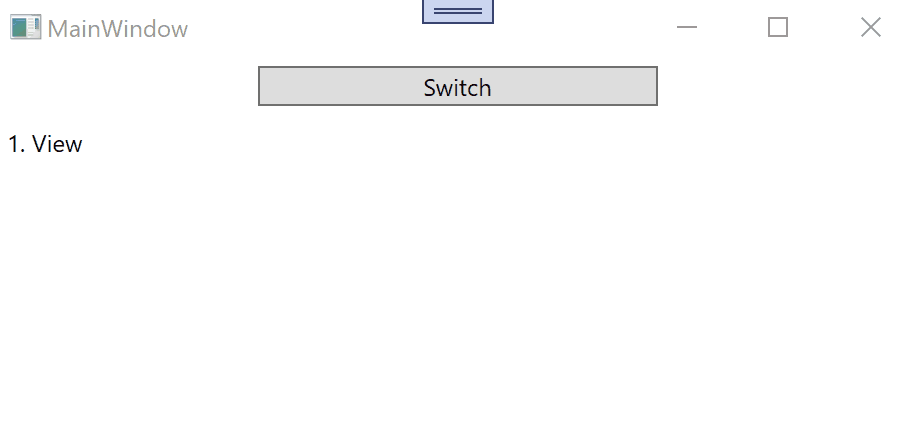Hi,
in ContentControl you can use Content = {Binding CurrentVM}.
Try following demo:
XAML MainWindow:
<Window x:Class="WpfApp1.Window033"
xmlns="http://schemas.microsoft.com/winfx/2006/xaml/presentation"
xmlns:x="http://schemas.microsoft.com/winfx/2006/xaml"
xmlns:d="http://schemas.microsoft.com/expression/blend/2008"
xmlns:mc="http://schemas.openxmlformats.org/markup-compatibility/2006"
xmlns:local="clr-namespace:WpfApp033"
xmlns:view="clr-namespace:WpfControlLibrary1;assembly=WpfControlLibrary1"
mc:Ignorable="d"
Title="MainWindow" Height="450" Width="800">
<Window.DataContext>
<local:ViewModel/>
</Window.DataContext>
<StackPanel>
<Button Content="Switch" Command="{Binding}" Width="200" Margin="5"/>
<view:Window033UC1 DataContext="{Binding CurrentVM}"/>
</StackPanel>
</Window>
Main ViewModel:
using System;
using System.ComponentModel;
using System.Runtime.CompilerServices;
using System.Windows;
using System.Windows.Input;
namespace WpfApp033
{
public class ViewModel : ICommand, INotifyPropertyChanged
{
public object CurrentVM { get; set; } = new WpfControlLibrary033.MyViewModel1();
public void Execute(object parameter)
{
if (CurrentVM is WpfControlLibrary033.MyViewModel2)
CurrentVM = new WpfControlLibrary033.MyViewModel1() { Info1 = DateTime.Now.ToString("mm:ss.fff") };
else CurrentVM = new WpfControlLibrary033.MyViewModel2() { Info2 = DateTime.Now.ToString("mm:ss.fff") };
OnPropertyChanged(nameof(CurrentVM));
}
public event EventHandler CanExecuteChanged;
public bool CanExecute(object parameter) => true;
public event PropertyChangedEventHandler PropertyChanged;
private void OnPropertyChanged([CallerMemberName] string propName = "") =>
PropertyChanged?.Invoke(this, new PropertyChangedEventArgs(propName));
}
}
XAML UserControl:
<UserControl x:Class="WpfControlLibrary1.Window033UC1"
xmlns="http://schemas.microsoft.com/winfx/2006/xaml/presentation"
xmlns:x="http://schemas.microsoft.com/winfx/2006/xaml"
xmlns:mc="http://schemas.openxmlformats.org/markup-compatibility/2006"
xmlns:d="http://schemas.microsoft.com/expression/blend/2008"
xmlns:local="clr-namespace:WpfControlLibrary1"
xmlns:view="clr-namespace:WpfControlLibrary033"
xmlns:vm="clr-namespace:WpfControlLibrary033"
mc:Ignorable="d"
d:DesignHeight="450" d:DesignWidth="800">
<UserControl.Resources>
<DataTemplate DataType="{x:Type vm:MyViewModel1}">
<view:MyViewModel1View DataContext="{Binding}"/>
</DataTemplate>
<DataTemplate DataType="{x:Type vm:MyViewModel2}">
<view:MyViewModel2View DataContext="{Binding}"/>
</DataTemplate>
</UserControl.Resources>
<ContentControl Content="{Binding}"/>
</UserControl>
ViewModels for UserControls:
using System.Windows.Controls;
using System.Windows.Data;
namespace WpfControlLibrary033
{
public class MyViewModel1
{
public string Info1 { get; set; }
}
public class MyViewModel2
{
public string Info2 { get; set; }
}
public class MyViewModel1View : UserControl
{
public MyViewModel1View()
{
StackPanel stp = new StackPanel();
this.Content = stp;
stp.Children.Add(new Label() { Content = "1. View" });
Label lbl = new Label();
lbl.SetBinding(Label.ContentProperty, new Binding("Info1"));
stp.Children.Add(lbl);
}
}
public class MyViewModel2View : UserControl
{
public MyViewModel2View()
{
StackPanel stp = new StackPanel();
this.Content = stp;
stp.Children.Add(new Label() { Content = "2. View" });
Label lbl = new Label();
lbl.SetBinding(Label.ContentProperty, new Binding("Info2"));
stp.Children.Add(lbl);
}
}
}
Result:

